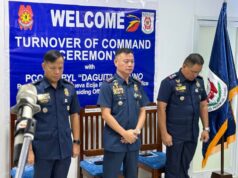“Living mannequins” perform native dances twice daily to the delight of local and foreign tourists.
Photo by Ding Cervantes
Anota brims with bullishness over Nayong Pilipino’s future in Clark. Photo by Bong Lacson
CLARK FREEPORT – There’s the inclination to thank the Ramos administration for the 60-hectare Expo Pilipino (or whatever it’s now called), except that the grateful sentiment dissolves before it is worded.
But for sporadic dots of concerts and other forgotten affairs at the failed centerpiece for the centenary of Philippine Independence in 1998, the huge park has largely been, uh, a brown elephant.
But not for long, if you hear it from lawyer Apolonia Anota, head of Nayong Pilipino sa Clark Expo. Well, as far as 3.5 hectares of the park complex can go, which is what Nayong Pilipino covers… so far.
“We will invest heavily here,” said Anota in a press conference amid replicas of native costumes of tribal folk from the north and south of the country.
Nayong Pilipino, he said, is an autonomous government corporation intending to earn under the wings of the Department of Tourism.
“The 3.5 hectare cultural amusement park will undergo a total rehabilitation. An approved budget of P50 million will be utilized…” said a press statement which named items for the funding: general repairs of structures including two museums, relandscaping, redesigning of air-conditioned cottages.
Plus some things new: a Palaruang Pilipino to serve as “venue for the reintroduction of traditional Filipino games, authentic Kalinga houses, T’boli village, orchidarium, among other fresh features.
The orchidarium should be of particular interest, said Anota. It will display unique orchids that resulted from local crossbreeding, numbering 45,000 including 20 new species.
Anota also said that the existing museums, at present with scanty artifacts, would expose unique collections of authentic Filipino weaves, some from 75 to 100 years old, and woven from skills now lost.
At one end of the Nayon will rise a collection of huts typical in Batanes, Bicol, Mountain Province, Mindanao where a “walk through” could be enjoyed towards a botanical garden where trees would be properly labeled with name, value and history.
Even now, there are “living mannequins” at Nayon, comprising 39 Nayon Pilipino-Clark dancers who perform folk dances twice almost daily near the replica of the historic Barasoain church. “They not only dance, but also demonstrate to visitors how to dance,” Anato said.
As if these are not enough to whet the urge to visit, Anato ticks off more: “changing exhibits” for new surprises for revisiting tourists such as sculptures of wood and ice and paintings.
There’s also the lagoon which the administration of Charito Planas filled up with water, but then, a school- to whom the former administration of the Clark Development Corp. rented out the rest of the Expo Pilipino- reportedly has insisted to be within its jurisdiction.
Anato now wants part of the lagoon, at least those that wind along Nayon, for tourism events that could be dubbed “Lagoon Show”. Boating there, of course, could be a serious come-on.
Already, things that should excite have been lined up at Nayon this summer: Santacruzan events on May 13 and 27 and, sometime in June, an Ati-Atihan competition.
Since Expo Pilipino itself is isolated from jeepneys and other forms of public transport, Nayong Pilipino authorities have made provisions for free shuttle service between its park and SM City-Clark in Angeles City, daily starting 8:30 a.m. with the trip back to the mall at 5:30 p.m.
“We will finish all the rehabilitation and fresh projects ahead of time, by May 12,” said Anato who is rushing to make Nayong Pilipino a major tourist destination at Clark, if not in the entire country, especially for tourists landing at the nearby Clark International Airport.



